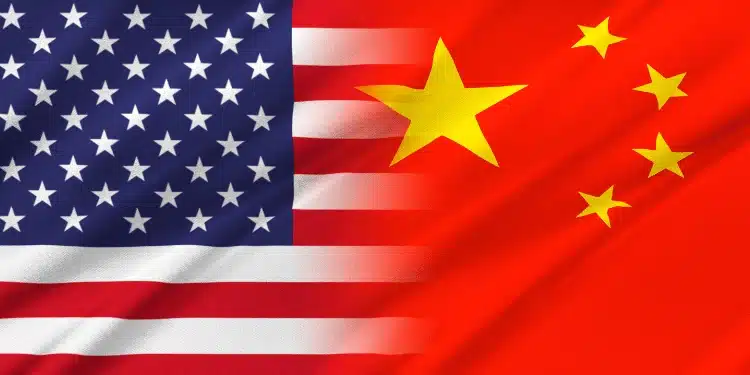Breaking Down China’s Latest White Paper: Key Positions on US Trade Relations Explained
Understanding the White Paper’s Context and Purpose
China’s recently released white paper on economic relations with the US comes at a significant time in the evolving dynamics between the two nations.
This document, titled “China’s Position on Some Issues Concerning China-U.S. Economic and Trade Relations,” hones in on the intricate nuances and importance of the bilateral economic relationship.
Overview of the White Paper
The white paper, issued by the State Council Information Office, outlines China’s viewpoint on various critical economic and trade issues with the United States.
It emphasizes the importance of the trade relationship, not just for the two countries but also for the stability and growth of the global economy.
This perspective is particularly relevant in light of recent disruptions largely caused by increasing U.S. unilateralism and protectionist policies.
Significance in Current Bilateral Trade Dynamics
The timing of this white paper’s release is critical.
Trade tensions and policy disagreements have strained the China-US relationship in recent years.
By emphasizing dialogue and cooperation based on mutual respect and mutual benefit, the document aims to counteract these tensions and steer the relationship back towards a more collaborative path.
The white paper underscores that both nations have reaped substantial benefits from their economic cooperation and reiterates that China does not pursue a trade surplus.
Structure and Main Objectives
The white paper is meticulously structured into six chapters.
It starts by affirming the mutually beneficial nature of China-US trade relations, setting a foundation for the deep dive into more specific issues.
The document’s primary objectives include:
This comprehensive structure ensures that the document addresses the multifaceted aspects of the trade relationship, providing both a thorough analysis and actionable insights.
As the white paper elaborates on these key topics, it becomes evident that China prioritizes the need for constructive dialogue and cooperation, aiming to foster a stable, healthy, and sustainable economic relationship with the United States.
This balanced approach is encapsulated throughout the document, underscoring a vision for peaceful coexistence and shared prosperity.
China’s Core Position on Bilateral Trade
Emphasis on Mutually Beneficial Nature of China-US Trade Relations
China’s newly released white paper unequivocally emphasizes the mutually beneficial nature of trade relations between China and the US.
This relationship is not only pivotal for the economic prosperity of both nations but also for the global economy.
Despite the complexities and disruptions faced in recent years, China highlights that economic cooperation has been substantially beneficial for both sides.

China’s Stance on Trade Surplus and Economic Cooperation
One of the key positions highlighted in the white paper is China’s stance on the trade surplus.
China clarifies that it does not intentionally seek a trade surplus with the US.
The emphasis is on the substantial gains both nations derive from robust economic cooperation.
By promoting dialogue, China aims to foster an environment where economic activities lead to a win-win situation for both nations.
Such collaboration is seen as a bedrock for resolving trade imbalances and fostering mutual growth.
Advocacy for Dialogue Based on Mutual Respect and Win-Win Cooperation
Underlying China’s position on bilateral trade is the advocacy for dialogue and negotiation, which are based on principles of mutual respect and win-win cooperation.
By fostering an environment where both countries can openly communicate, China believes it is possible to resolve existing tensions and build a sustainable economic relationship.
This approach seeks to minimize confrontational stances and bolster mutual trust.
These core positions not only underscore the importance of current economic interactions but also aim to set the stage for enhanced cooperation.
Looking forward to continued progress, the white paper transitions to discussing the implementation of the phase-one trade agreement and other critical commitments.
Implementation of Phase-One Trade Agreement
China’s newly released white paper puts a spotlight on the country’s efforts to uphold the commitments outlined in the Phase-One Trade Agreement with the United States.
A key focus is on strengthening intellectual property (IP) protection, expanding market access, and maintaining open communication channels with US authorities.
Strengthening Intellectual Property Protection
China has taken significant steps to bolster its intellectual property regulation framework.
The government has rolled out several measures to enhance IP protection, ensuring that foreign enterprises can operate with greater confidence in the security of their patents, trademarks, and copyrights.
These initiatives are aimed at fostering innovation and addressing some of the longstanding concerns raised by international businesses.
Expanding Market Access and Prohibiting Forced Technology Transfers
The white paper details the strides made in expanding market access for US products and services.
Specifically, China highlights the market openings in several key sectors:
- 🗎 Food
- 🗎 Agriculture
- 🗎 Financial services
Moreover, China has implemented reforms to prohibit forced technology transfers, which has been a point of contention in bilateral trade negotiations.
These measures are designed to create a more equitable environment for foreign companies, ensuring that technology and knowledge transfers are based on voluntary agreements rather than regulatory compulsion.
Practical Communication Channels with US Authorities
To keep the lines of dialogue open, China has maintained practical and effective communication channels with US trade authorities.
This ongoing engagement is crucial for monitoring the implementation of the Phase-One Trade Agreement and addressing any emergent issues promptly.
By fostering a cooperative atmosphere, China aims to prevent misunderstandings and build a foundation for smoother economic relations.
These concerted efforts underscore China’s commitment to fulfilling its obligations under the Phase-One Trade Agreement, reinforcing the importance of mutual respect and cooperation in international trade relations.
Next, we will explore China’s adherence to international trade standards, which further solidifies its role in the global economic framework.
China’s Commitment to International Trade Standards
Adherence to World Trade Organization (WTO) Rules and Principles
China’s newly released white paper underscores its steadfast adherence to the rules and principles of the World Trade Organization (WTO).
The document highlights China’s commitment to fostering international trade relations based on fairness, transparency, and reciprocity.
By aligning with WTO regulations, China aims to contribute to a stable and predictable global trade environment.
Progress in Trade Policy Compliance and Tariff Reduction Commitments
The white paper details China’s significant strides in fulfilling its trade policy compliance and tariff reduction commitments.
Over the years, China has made concerted efforts to lower tariff rates and ease trade barriers.
These measures not only facilitate smoother market access for trading partners but also enhance the overall competitiveness of Chinese products and services in the global market.
The commitment to reducing tariffs reflects China’s dedication to promoting a free and open trade system that benefits all parties involved.
Efforts in Optimizing Business Environment and Managing Subsidies
China is committed to enhancing its business environment, as highlighted in the white paper.
The country has introduced various reforms to simplify regulatory processes and create a more favorable environment for both domestic and international businesses.
These efforts include enhancing legal protections for foreign enterprises and ensuring equal treatment within the Chinese market.
Additionally, China has been proactive in managing and regulating subsidies to align with international norms.
By doing so, China aims to prevent any distortions in trade that could arise from unfair competitive advantages.
The adherence to these principles is indicative of China’s commitment to maintaining a level playing field in international trade.
As we consider these advancements, it is evident that China’s commitment to international trade standards is a crucial part of its overall economic strategy.
Looking ahead, this emphasis on compliance and optimization will significantly influence the future of global trade relations.
Criticisms of US Trade Practices
Concerns Over US Expansion of National Security Definitions
The latest Chinese white paper highlights significant concerns regarding the US’s broadening of national security definitions.
This expansion is seen as a tactic to justify trade restrictions and protectionist measures.
According to the document, these practices create an unpredictable business climate, affecting not just Chinese companies but the global supply chain.
By frequently invoking national security, the US has imposed various trade barriers, disrupting normal commercial interactions.
This, China argues, undermines mutual trust and hampers the potential for stable economic relations.
Issues with Imposed Reciprocal Tariffs and Export Controls
China’s white paper also raises issues with the US’s imposed reciprocal tariffs and export controls.
The trade conflict escalated with the implementation of additional tariffs on Chinese goods, prompting China to retaliate in kind.
This tit-for-tat strategy has led to spiraling trade tensions, affecting businesses and consumers in both countries.
On export controls, the white paper indicates that the US’s stringent measures on technology exports have hindered Chinese companies’ development and impacted the global tech industry.
Impact of US Actions on Bilateral Economic Relations
The cumulative effect of these US actions has been detrimental to China-US economic relations.
The white paper points out that such measures violate the principles of fair trade, leading to economic instability and uncertainty.
This has not only hurt businesses in both countries but also strained diplomatic ties, reducing opportunities for collaborative projects.
The document calls for a return to dialogue and cooperation to rebuild a stable and sustainable economic relationship based on mutual respect and benefit.
Path Forward for China-US Trade Relations
Call for Dispute Resolution through Dialogue and Cooperation
The latest white paper from China emphasizes the importance of resolving trade disputes through calm and collaborative dialogue.
China urges that any disagreements be addressed on the basis of equality and mutual respect.
This approach, China believes, will pave the way for constructive problem-solving and prevent the escalation of trade tensions.
Both nations stand to gain significantly from settling disputes amicably, as opposed to through confrontation.
Vision for Stable, Healthy, and Sustainable Economic Relationship
China envisions a long-term economic relationship with the US that is stable, healthy, and sustainable.
This vision is underpinned by the belief that cooperation and mutual benefit will yield the best outcomes for both countries.
By fostering a stable trade environment, both economies can flourish and contribute positively to the global economic landscape.
A healthy trade relationship will allow both China and the US to play pivotal roles in driving global economic growth.
Emphasis on Peaceful Coexistence and Mutual Benefit
Central to China’s vision is the principle of peaceful coexistence.
The white paper underscores the need for the US to work alongside China based on mutual respect and collective gain.
By focusing on shared interests, both nations can avoid unnecessary conflicts and foster a spirit of international camaraderie.
This cooperative approach will help ensure that the economic gains are fairly distributed, benefiting not just China and the US, but the entire global economy.
Moving forward, the emphasis on dialogue, stability, and mutual benefit will be paramount in shaping the future of China-US trade relations.





